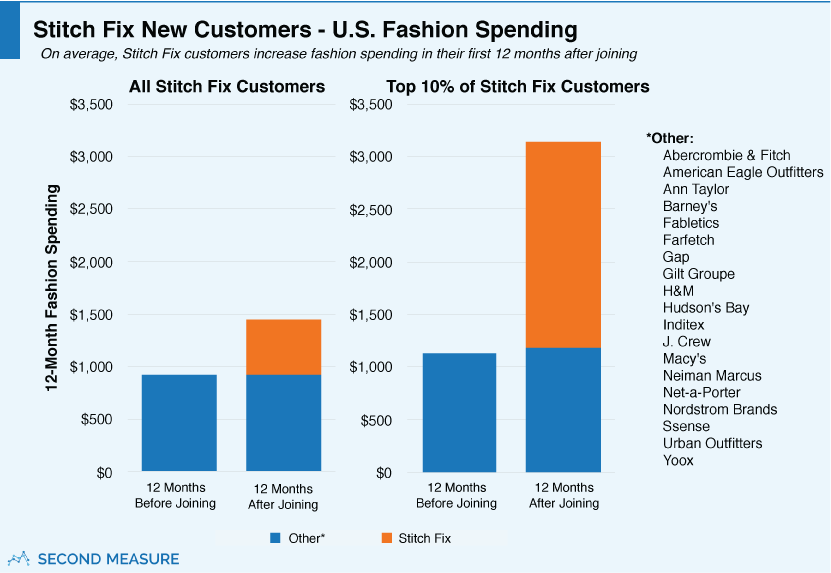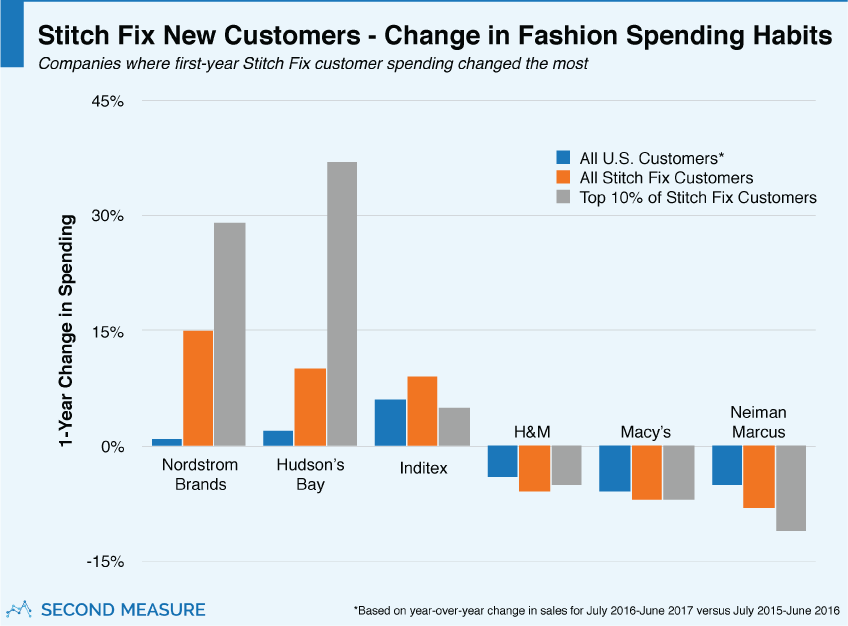NOTE: Bloomberg Second Measure launched a new and exclusive transaction dataset in July 2022. Our data continues to be broadly representative of U.S. consumers. As a result of this panel change, however, we recommend using only the latest posts in assessing metrics, and do not support referring to historical blog posts to infer period-over-period comparisons.
The impressive rise of subscription clothing company Stitch Fix has left a lot of America’s struggling fashion retailers shaking in their sale-priced boots. But new data reveals those fears may be unfounded. Joining Stitch Fix didn’t change what customers spent at traditional fashion retailers, but it did dramatically increase how much they spent on fashion overall.
Those are the findings from our analysis of fashion spending among customers who joined Stitch Fix in 2016. We compared their spending at Stitch Fix plus 19 other major fashion retailers for the 12 months before and after they joined the mail-order styling service. And after starting Stitch Fix, overall fashion spending increased—a lot.
Prior to joining Stitch Fix, customers spent an average of $920 on clothing and accessories across these fashion retailers, including Macy’s, Nordstrom, Gap, and Urban Outfitters. But in the year after joining, their average wardrobe spending jumped almost 60 percent to $1,450—$525 at Stitch Fix and $925 at other sellers.
The increase was even more pronounced among the top 10 percent of Stitch Fix spenders. For them, wardrobe spending nearly tripled in the year after joining Stitch Fix. They spent an average of $1,130 in the year before trying the service and $3,140 in the year after; $1,180 of which was at other retailers.

Why Stitch Fix creates more passion for fashion
As the data reveals, Stitch Fix complements, rather than replaces, spending at traditional fashion retailers.
How? Stitch Fix carries over 1,000 men’s and women’s brands, many of which are also stocked by traditional fashion retailers. It’s easy to imagine a customer discovering a new favorite fashion label through Stitch Fix, then hitting the mall in search of more pieces by that brand. Every item in a shipment also comes with an illustrated “style card” suggesting clothing that would pair well with the piece. Stitch Fixers who like what they see on the cards might head to their favorite stores to complete their new looks.
The blogosphere is also filled with tales of Stitch Fixers who liked the items in their boxes—but not the price tags. After a customer received a Stitch Fix shipment including shorts with a Nordstrom Rack markdown price tag, the company admitted to selling some of the same clothing as other retailers, often at higher prices. It’s possible that some spending at traditional retailers is driven by customers bargain-hunting for Stitch Fix items they liked but returned.
A few stores benefited the most
While customers’ overall spending at traditional fashion retailers is relatively unaffected by joining Stitch Fix, the service does appear to create some winners and losers. Top amongst the winners is Nordstrom, including brands Nordstrom Rack, flash sale website HauteLook, and style-box competitor Trunk Club. In the year before joining Stitch Fix, per-customer spending across these brands averaged $200. In the year after, spending jumped 15 percent to $230.
The effect was even more pronounced among Stitch Fix’s top 10 percent of shoppers. Their spending increased 29 percent, from an average of $270 the year before to $350 the year after their first fix.
In some ways, Nordstrom and Stitch Fix are a perfect fit. Not only do they offer some of the same labels, including Kate Spade, Theory, and Free People, but Nordstrom-brand stores were amongst the most popular fashion destinations for new Stitch Fix customers before they joined the service. Thirty-nine percent made at least one Nordstrom-brand purchase in the year preceding their first fix, a figure rivaled only by that of Gap brands (64 percent) and Macy’s (46 percent).
Another company basking in Stitch Fix’s glow is Hudson’s Bay, the parent company of Saks Fifth Avenue, Saks Off 5th, and Lord & Taylor. At Hudson’s Bay brands, customers increased their spending 10 percent in the year after joining Stitch Fix. And the best customers—the top 10 percent of spenders—increased their spending by 37 percent in the year after joining Stitch Fix. Hudson’s Bay, like Nordstrom, may benefit from offering some of the same fashion labels as Stitch Fix through its Saks Off 5th stores.
Stitch Fixers’ spending increases surpass national sales trends at both of these companies as well as at Inditex, parent company of Zara, where sales were up 9 percent for new Stitch Fix customers. In the one-year period between Q3 2016 and Q2 2017, Nordstrom’s overall sales were up only 1 percent, Hudson’s Bay’s sales were up only 2 percent, and Inditex’s sales were up 6 percent. This indicates that joining Stitch Fix really does change the fashion-spending habits of its clients.

Although Stitch Fix customers’ spending beat national trends for Inditex, the company didn’t get the same spending boost from Stitch Fix’s top spenders. This may reflect the fact that Inditex doesn’t carry Stitch Fix brands, making it harder for Fixers to comparison shop.
J. Crew is another interesting case. New Stitch Fix subscribers spent 3 percent less at J. Crew after joining Stitch Fix, but this is actually something of a win for the struggling retailer because sales were down 7 percent nationally over the same time range.
Stitch Fix isn’t helping all fashion retailers, but it’s not hurting them much either
Not all fashion retailers are cashing in on new Stitch Fix customers. In the year after joining the styling service, customers’ spending was 6 percent lower at H&M, 7 percent lower at Macy’s, and 8 percent lower at Neiman Marcus than in the year before joining. In this regard, new Stitch Fix customers have roughly the same attitude about these companies as U.S. consumers in general. Shoppers overall have driven down sales at H&M by 4 percent, at Macy’s by 6 percent, and at Neiman Marcus by 5 percent over the same period.
Stitch Fix is still tailored for growth
To date, less than 3 percent of U.S. consumers have ever tried Stitch Fix. For comparison, more than one-third have shopped at a Nordstrom brand and more than half have shopped at Macy’s since 2011, the year Stitch Fix was founded. Clearly, Stitch Fix has a lot of room to grow, and many companies have reason to cheer, rather than fear this growth.
Have a business question that would be a perfect fit for our data? Request a demo today.
Oh, and we’re hiring.
